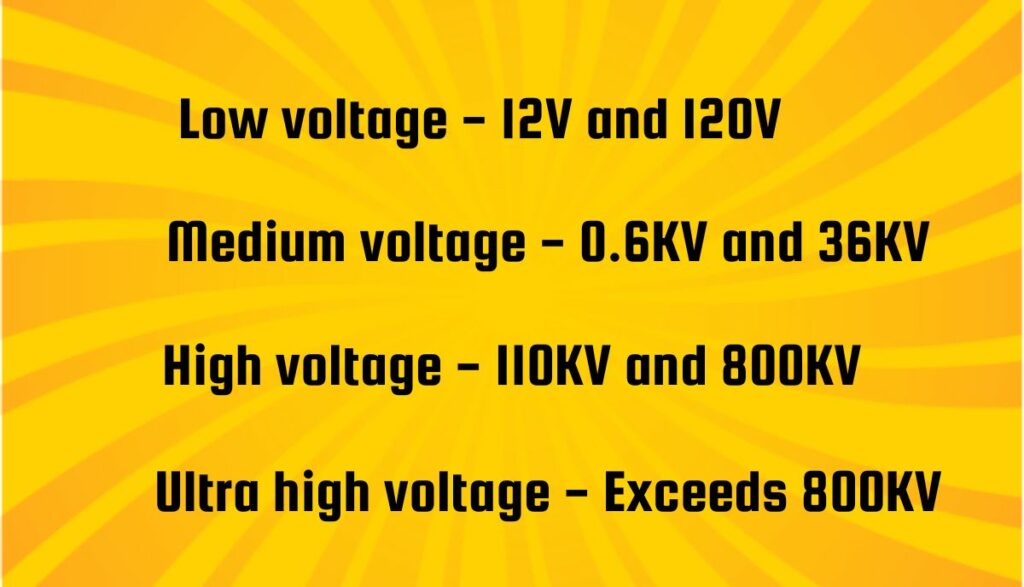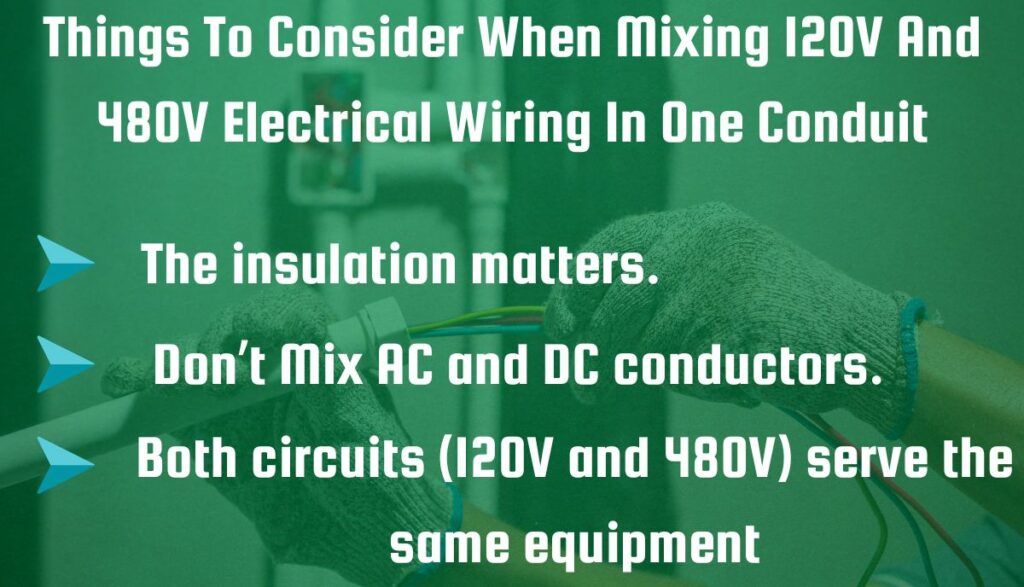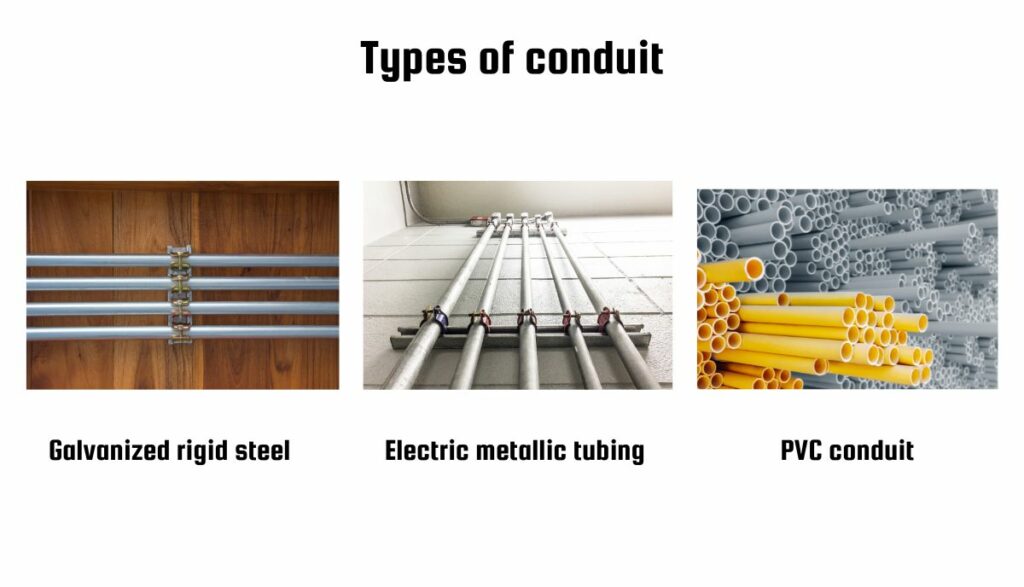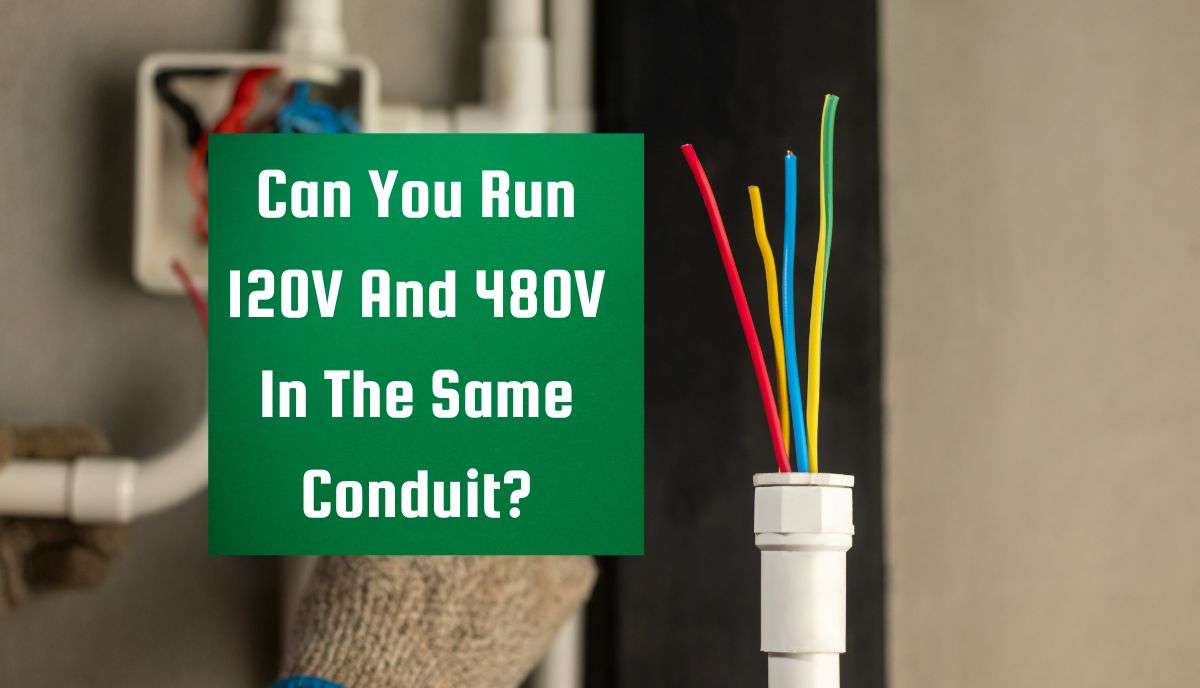Yes, you can run 120V and 480V in the same conduit, and your local code will most likely permit the practice. Some people disagree. They think the NEC and other electric codes are designed to set the minimum standard to which contractors should adhere.
However, a licensed professional should endeavor to exceed the minimum standard. That is the only way to protect consumers from fire and electrocution hazards. In that regard, keeping 120V and 480V wiring in separate tubes is safer. You can still terminate them in the same control box.
But what if your particular situation compels you to run both voltages through the same raceway? Should you worry? Not necessarily. Engineers don’t want high and low-voltage lines to share raceways.
They are not wrong. The practice attracts many adverse consequences, such as interference. You can’t rule out the possibility of the high-voltage line inducing a voltage on its low-voltage counterparts.
However, those concerns are unlikely to apply to 120V and 480V. Why? Because 120V and 480V are in the same voltage class. You can categorize them both as low-voltage systems. This comes as a surprise because 480V seems so much higher than 120V, hence the confusion regarding their ability to share a conduit. CAN Electric 247 has identified four voltage categories, namely:

- Low Voltage
The layperson thinks that LV ranges between 12V and 120V. But this category extends all the way to 600V. An electrician may call it ‘Utilization Voltage’ because it runs your home’s lighting and appliances.
It appears in residential settings as 120V and 240V and in commercial buildings as 120, 240, 277, 347, 480, and 600V.
- Medium Voltage
This option ranges between 0.6KV and 36KV. MV appears in primary distribution lines. A transformer may alter this voltage to fit various purposes.
- High Voltage
HV ranges between 110KV and 800KV. You will find it in transmission networks.
- Ultra-High Voltage
UHV exceeds 800KV.
Voltage less than 50V is ELV (Extra Low Voltage). EECO notes that ELV doesn’t pose a shock hazard (according to the NFPA 70E).
The exact classification for electrical systems may vary from location to location. However, most electrical codes agree that 480V is not high enough to qualify as a high-voltage system. Once you accept that fact, you begin to understand why many contractors are unconcerned about the notion of using the same conduit for 120V and 480V.
What Are The Considerations And Challenges When Mixing 120V And 480V Electrical Wiring In One Conduit?
- Neither wire will present much of a challenge because they don’t differ as drastically as people think.
- That said, the insulation matters. Don’t mix insulation ratings. The insulation should match the maximum voltage in the conduit. In this scenario, aim for 600V. Jmraef, from this Reddit post, has noticed that many wires already possess 600V insulation.
- ECO SOCH warns against mixing AC and DC conductors. They expect the DC line to induce a DC voltage on the AC system. However, they also admit that trunking with an internal divider can solve the problem by keeping the cables separate.
- Jason, a service electrician with more than two decades of experience, has highlighted the importance of making sure that both circuits (120V and 480V) serve the same equipment. Otherwise, you will violate the electrical code.

Don’t forget the questions contractors typically ask when you express your desire to pull wires through a conduit, for instance:
- What is the distance you intend to cover? This will determine the length of the conduit. Shorter runs are less challenging than their longer counterparts.
- What type of conduit do you want? They come in numerous sizes and forms, each boasting a different set of attributes.
- How many bends do you expect to encounter? What about the angles? Some conduits are easier to bend than others. Additionally, you can damage a cable by pulling it around a bend.
- How many cables will share the conduit? This affects the size of the tubing. The bigger the number of wires, the larger the conduit.
It is worth noting that the voltage won’t influence the cable size. A 480V wire isn’t necessarily thicker than 120V wiring. The wire’s size grows with the current, not the voltage. Don’t assume that 480V will consume more space than 120V in the conduit.
Are There Specific Electrical Codes Or Regulations Regarding Mixing These Voltage Levels In A Conduit?
- Article 300.3C of the NEC permits the mixing of 600 volts or less within the same enclosure or raceway. However, each conductor’s insulation rating should match the maximum voltage in the enclosure. In other words, a 120V wire’s insulation should be rated for 480V at a minimum.
- The NEC emphasizes the importance of protecting cables from harsh elements. For instance, without a conduit, a contractor can puncture the cables while hammering a nail into the wall. Therefore, you shouldn’t forego the conduit simply because you don’t want 120V and 480V to share the same tubing.
- Mixing 120V and 480V wiring is one thing. Article 300.8 of the NEC warns against placing lines from other systems in the same conduit. For instance, you can’t include water and gas lines in an enclosure with electrical wiring.
- Give the enclosures supporting structures independent of other systems.
- Stay abreast of changes to the NEC. Don’t rely on outdated versions of the code.
- Consult the local code before you proceed. The local code supersedes the NEC. Therefore, you can’t base your decisions on the NEC’s rulings alone. If the local code contradicts the NEC on the issue of 120V and 480V wiring in the same conduit, obey the local code.
- If the local code seems vague or confusing, consult a local electrician. They have a better grasp of local regulations.
Tips For Maintaining Safety When Combining Different Voltage Wires In A Conduit?
- Don’t tamper with 120V and 480V lines without switching the power off. You should also wear protective gear. If you must work on a live circuit, get help. An assistant can save your life if an electric shock prevents you from letting go of a live wire.
- According to EC&M, the insulation voltage rating should equal or exceed the maximum circuit voltage. They base this on NEC 300.3C.
- Don’t mix 120V and 480V if one of them works with emergency power systems.
- You should also apply caution or separate the wiring if 120V connects to a sensitive device.
- Don’t add communication lines to the conduit. Proper shielding can minimize, possibly even eliminate, the noise that arises in this situation. However, it can’t provide any guarantees.
- If the conduit combines AC and DC lines, use a divider to separate them. This separation should persist for the entirety of the conduit.
- Inspect the conduit for sharp edges and foreign objects. Remove unnecessary bends.
- Apply lubricant to cables before pulling them through the tubing. This protects them from friction.
This OSHA guide (U.S. Department of Labor) shows consumers how to pull wires through enclosures. However, if the 120V and 480V systems inhabit a commercial setting, ask your employer for a list of instructions and safety protocols.
Find out whether the company has published a guide that regulates this process. If they haven’t, you can pull 120V and 480V cables through a conduit the same way you would other wires.
What Type Of Conduit Should Be Used For Containing Both 120V And 480V Wiring?
The conduit type you select depends on the desired attributes, not the voltage. Different conduit types use different materials. This affects their properties. For instance, galvanized rigid steel appears in industrial applications because of its impact resistance.

Electric metallic tubing can appear in residential applications. But it has thin walls that can’t tolerate physical damage. PVC is popular because of its light construction. Additionally, the material is non-conductive. Assess the environment and identify a conduit type that fits the application’s needs.
Are There Potential Interference Issues When Running These Voltages Together?
Pairing high-voltage lines with communication cables can create interference. The higher-voltage wires can induce a voltage in the lower-voltage wires. This can affect sensitive circuits. It can also generate noise on the line.
How Can I Properly Label And Identify 120V And 480V Wires Within The Same Conduit To Avoid Confusion?
Invest in cable markers to prevent costly mistakes and improve clarity. The correct cable marker will take the following into consideration:
- Environment – can the label withstand the elements in the vicinity, such as moisture and chemicals?
- Code – Does the label adhere to local or national regulations and standards?
- Size – Is the label big enough for people to read at a glance?
- Application – Does the label match the application? The colors you use in an office will differ from those in a factory.
- Information – the label should reveal the voltage, source connection, usage, and any other information contractors and laypeople need.
- Color Scheme – You can apply any color scheme you want if it meets the local code’s standards. Additionally, you should maintain consistency.
- Marker Type – Choose a cable marker type that suits you. Your options include attached, adhesive, wraparound, and electrical markers. You can also experiment with identification tags, zip ties, and cable flags.
What Precautions Should Be Taken When Designing Electrical Circuits With Mixed Voltage Levels In A Conduit?
- Use the correct insulation rating. The conductors should be rated for 600V.
- Don’t mix AC and DC within the same conduit.
- Use a divider. Keep the high and low-voltage wires separate.
- Don’t apply this setup if the wires run to a sensitive device, such as a digital input.
What Are The Common Applications Or Scenarios Where 120V And 480V Wiring Might Need To Be Combined In A Conduit?
120V is a standard household voltage, while 480V appears in commercial settings. However, applications with 480V motor leads and 120V control wires in the same enclosure are relatively common.
‘Guy’ from this Electrician Talk forum has given the example of 120V control wiring and 480V power lines for an actuator valve.
Some people pull 120V and 480V wires through the same conduit even though they serve different circuits because it’s cheaper than giving each voltage a separate pipe.

